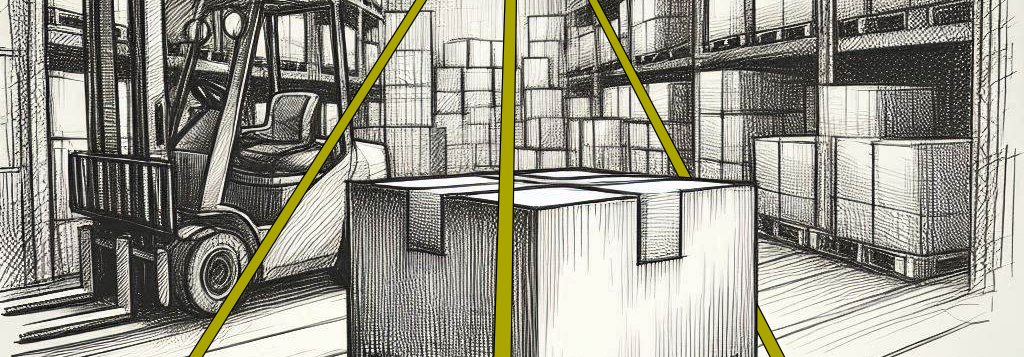If there is a box on a pallet which will have to be lifted and you were asked to calculate the force in each of the three slings, then use vectors!

Imagine a coordinate system with the x-axis along one edge of the pallet and the y-axis along the other and the z-axis vertical, then define points P_1, P_2 and P_3 where the slings or chains are attached to the pallet. The point where the slings intersect is called P_h, this is also where the crane hook is attached and lifts the goods. We know that the slings exert force on the pallet and hook in the direction of their length. These directions are indicated by blue arrows in the drawing and can be computed by:
n_i = \frac{P_i-P_h}{\left|P_i-P_h\right|}
It is assumed that the sling lengths are adjusted so that the hook is located exactly above the center of gravity of the goods so that the pallet will stay level when lifted. Then, the sum of sling forces must equal the hook force that the crane applies to lift the goods. This can be written as
0 = F_h + n_1\cdot T_1 + n_2\cdot T_2 + n_3\cdot T_3
Where T_1, T_2 and T_3 is the lashing tension as a scalar value. This is rewritten in matrix form:
-F_h = \left[n_1, n_2, n_3\right]\cdot\left[ \begin{matrix} T1\\T2\\T3 \end{matrix} \right]
This system of linear equations can be solved using MATLAB, Python, MathCad, Excel and possibly in many other ways. If somebody asks at which angle does one of the slings lean then just calculate it: \alpha_i = acos(n_{i,z}).
Use these numbers as an example:
| A | B | C | D | |
| 1 | P_h | P_1 | P_2 | P_3 |
| 2 | 0.5 | 0.1 | 0.8 | 0.1 |
| 3 | 0.4 | 0 | 0.3 | 0.7 |
| 4 | 2 | 0 | 0 | 0 |
Compute the direction vectors by subtracting the hook point from the points on the load by writing “=B2:D4-A2:A4” in cell B6. The direction vectors are computed by “=B6#/B9:D9” in cell B11.
| A | B | C | D | E | |
| 6 | -0.4 | 0.3 | -0.4 | ||
| 7 | -0.4 | -0.1 | 0.3 | ||
| 8 | -2 | -2 | -2 | ||
| 9 | Length | 2.08 | 2.02 | 2.06 | |
| 10 | F_h | n_1 | n_2 | n_3 | T |
| 11 | 0 | -0.1925 | 0.1482 | -0.1940 | 106 |
| 12 | 0 | -0.1925 | -0.0494 | 0.1455 | 579 |
| 13 | -1000 | -0.9623 | -0.9877 | -0.9701 | 337 |
The direction vectors are already written as a matrix above. Enter
“=MMULT(MINVERSE(B11#);A11:A13)”
in cell E11 to solve the system of linear equations (if you chose to use a spread sheet). The leaning angles of the slings are: 15.79, 8.98 and 14.04 degrees from vertical in this example.

